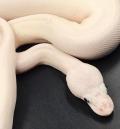» Site Navigation

2 members and 3,416 guests
Most users ever online was 6,337, 01-24-2020 at 04:30 AM.
» Today's Birthdays

» Stats

Members: 75,097
Threads: 248,540
Posts: 2,568,748
Top Poster: JLC (31,651)
|
-
het appearance question???....should be interesting
so many are asking around about hets....how can you tell if an animal is a het seems to be the most likely question. i would like to get opinions on what hets are TRULY visible. i mean without a doubt, hey look thats a het becasue.....and be sure to tell why.
for example, het pieds have the funny belly pattern right along the sides of the belly. but this only happens sometimes so i would throw it out.....well kinda. unless it came from a pied parent.
-
-
Registered User

Re: het appearance question???....should be interesting
Co-doms have fairly noticeable hets 
-
-
Re: het appearance question???....should be interesting
Yellow belly is a visual Het
Pastel is a Visual Het
If you think about it....Mojo's Lessers and Butters are Hets as well
-
-
Re: het appearance question???....should be interesting
For simple recessive, the best way to tell is to buy offspring from someone that bred a visual to something else; for example, an albino to a normal or an albino to a het. This is the only way to be sure that the het is a het.
To he best of my knowledge, there is no sure fire way to tell a simple recessive het by appearance. I do own a couple of het pied females, and they do have the het pied marker, but I have heard that some do not.
Eddie Strong, Jr. 
-
-
BPnet Veteran


Re: het appearance question???....should be interesting
You can't just look at an animal and say "oh yeah, that's a het" (and I'm only talking recessives here). But if someone tells you that, "this is a het albino", you can usually tell. They have this look to them that's kind of hard to describe. But like Pieds, it's not a 100% marker; it's just a "family trait".
-
-
Re: het appearance question???....should be interesting
 Originally Posted by bait4snake

You can't just look at an animal and say "oh yeah, that's a het" (and I'm only talking recessives here). But if someone tells you that, "this is a het albino", you can usually tell. They have this look to them that's kind of hard to describe. But like Pieds, it's not a 100% marker; it's just a "family trait".
i fully agree. i think people but too much weight on markers in general.
ive also herd/seen people state that there are markers for axanthics?!?! are there any (and i like that work you used) family traits for axanthic?
also i kinda agree on a yellow belly being a het but as for pastel....not really. not doggin you patrick your cool....even though your emo and hate your life!
-
-
Re: het appearance question???....should be interesting
Pastels het for axanthic look much different than a normal pastel. They have less yellow (hypoxanthic?).
-
-
Re: het appearance question???....should be interesting
Take the het... look closly at it... and then thank Adam or Ralph for the wonderful new snake
If you look at doms or codoms het for pied they have an odd look to them.
- Matt
Come here little guy. You're awfully cute and fluffy but unfortunately for you, you're made of meat
-
-
BPnet Veteran

Re: het appearance question???....should be interesting
You people are grasping at straws. If a het is visibly different than a normal it is not a recessive...it would be a dominant or co-dom trait.
There are no "markers" for recessives.
-Steven
-
-
Re: het appearance question???....should be interesting
I don't doubt that there are text book recessive mutations where the normal allele completely and always covers the mutant allele in the hets. But I also think ball pythons don't read those text books and there is some gray area between classic recessive and co-dominant and some morphs that we decided to call recessive fall into that gray area. Maybe there is a simple Mendelian explanation like different alleles that all get lumped together as normal but with different levels of dominance with their mutant allele. Or maybe more complicated genetics involving penetrance and expressivity are coming into play.
Most people seem to like things cut and dry. We want everything to fall into one neat classification or another. We want to consider a possible het a normal because it's simpler than living in that gray area between proven het and known normal. And we sure don't know what to do with a "recessive" mutation like piebald with sporadic co-dominant tendencies. Itís the sporadic part that really complicates things.
-
 Posting Permissions
Posting Permissions
- You may not post new threads
- You may not post replies
- You may not post attachments
- You may not edit your posts
-
Forum Rules
|








 Reply With Quote
Reply With Quote



